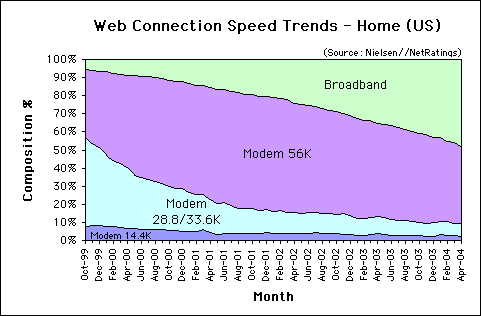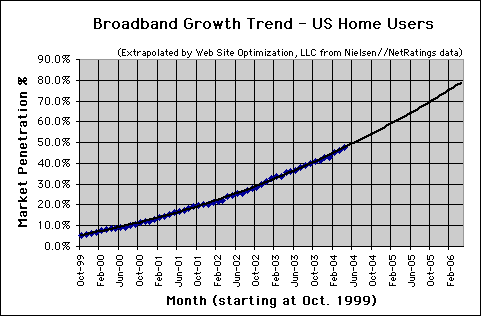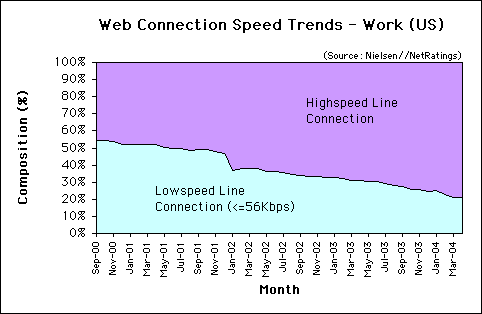US broadband penetration grew by 1.9 percentage points in April, with 47.87% of active Internet users enjoying a high-speed connection at home. This jump of nearly 2 points is 2.5 times the average rate of broadband growth. 52.13% of US home users dial into the Internet with “narrowband” connections of 56Kbps or less. Meanwhile, broadband growth in other countries suggests a plateau at 75% saturation.
The charts below, derived from Nielsen//NetRatings data, show trends in connection speeds to the Internet for users in the United States.*
Home Connectivity in the US
As of April 2004, most users in the US connect to the Internet using dial-up modems of 56Kbps or less. 42.74% use 56Kbps modems, 6.99% use 28/33.3Kbps, and 2.4% use 14.4Kbps modems. In total. 52.13% of home users in the US connect to the Internet at 56Kbps or less (see Figure 1).
Web Connection Speed Trends – Home Users (US)
Figure 1: Web Connection Speed Trends – Home Users (US)
Source: Nielsen//NetRatings
Broadband Growth in the US
Broadband penetration in the US increased by 1.9 points in April. As of April 2004 broadband penetration was at 47.87%, up from 45.97% in March. This jump of 1.9 points is 2.5 times higher than the average increase in broadband of 0.76 points per month from October 1999 to February 2004. Extrapolating the data provided by Nielsen//NetRatings, broadband share in the US should exceed 50% by July of 2004 (see Figure 2).
Broadband Connection Speed Trend – Home Users (US)
Figure 2: Broadband Connection Speed Trend – Home Users (US)
Extrapolated from Nielsen//NetRatings data
Work Connectivity
Most workers in the US enjoy high-speed connections to the Internet. Most use a high-speed line such as a T1 connection, and share bandwidth between computers connected to an Ethernet network. The speed of each connection decreases as more employees hook up to the LAN. As of April of 2004, of those connected to the Internet, 79% of US users at work enjoy a high-speed connection, up from 78.8% in March. 21% connect from work at 56Kbps or less (see Figure 3).
Web Connection Speed Trends – Work Users (US)
Figure 3: Web Connection Speed Trends – Work Users (US)
Source: Nielsen//NetRatings
Broadband Saturation Plateau?
Is there a broadband saturation limit? Canadian broadband and Korean broadband data suggest at least a short term broadband saturation plateau of 70% to 75%. We asked Marc Canter, CEO of Broadband Mechanics about a broadband saturation limit.
“Everything we have right now is simply mid-band. The world will be in constant transition as dial-up (unfortunately) won’t go away. YES there is saturation at 75% – but until there are enough compelling apps and services that REQUIRE broadband – we’re stuck with that reality.”
We asked Chris Ferneyhough, Vice President of Ipsos-Reid, why he thought Canadian broadband penetration growth is tapering off.
“I think it is tapering off because there is a sizable segment of the population that will always be content with dial-up. They don’t spend a lot of time online, and realistically the majority of the time they do spend online is just to check email. Additionally, people who live in rural areas simply don’t have access to high speed. My guess is that the limit will likely be around 75%.”
We asked Bruce Leichtman, President of Leichtman Research Group, why broadband adoption is slowing in Canada and other countries.
“In the US we don’t have to worry too much about broadband saturation right now as only about 36% of online subscribers have broadband today (despite what others may say). The broadband decision comes down to a price/value equation – every day consumers (in many countries) are making the decision if the added benefits of broadband are worth the price. Eventually you come to a point where fewer people make the decision that it is worth the price. Even if the price is the same as dial-up there will always be a group of people who are comfortable with what they have and don’t want to change.”
Kenneth Cassar, Director of Strategic Analysis at Nielsen//NetRatings said this about the growth of broadband.
“The broadband market has gone from immature (1997 to 2000)
to adolescence (2001-2005 or 2006) to mature (2006). We will enter maturity at around 66%-70% penetration when the growth will slow from 10+ points a year to single digit growth, due to a variety of factors.”
Some of the factors that affect the growth of broadband are:
- Price – broadband costs more than dial-up.
- Infrastructure – cable and phone companies have not built out their infrastructure to remote and rural areas yet. They require a certain density of population to justify building out their infrastructure. Once economies of scale kick in and consumer demand increases you’ll get better uptake of broadband in these remote areas.
- Peer pressure – you send large files to others. “Why don’t you upgrade?”
Further Reading
- FCC: Local Telephone Competition and Broadband Deployment
- Broadband penetration data by state from the FCC.
- Ipsos-Reid
- Supplies the Canadian broadband penetration data for the Bandwidth Report.
- Nielsen//NetRatings
- Provides the US broadband data for the Bandwidth Report.
- PEW Internet and American Life Reports
- Research, surveys, and analysis of Internet activity in America from PEW. Includes wireless penetration, broadband adoption, and Internet usage.
*Note that Nielsen//NetRatings reports the percentage of active Internet users that use broadband from home, not broadband households. NetRatings uses a panel of 40,000 to 50,000 people with software meters installed on their computers. These meters detect connection speeds. Each month they do an enumeration study to call a number of people to calibrate the panel by adjusting weightings
to match the population at large.
The Bandwidth Report is featured monthly on URLwire – news of useful and unique web content since 1994.



